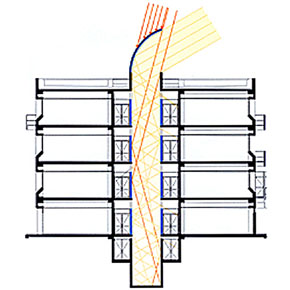|
|
|
Retrofit Concept
The decision for the first stage of retrofits, involves an integrated
design approach, using a combination of standard as well as innovative
energy conservation measures, which utilise passive solar and
Photo voltaic (PV) systems in order to achieve the best possible
levels of thermal and lighting comfort for the users, whilst reducing
fossil fuel and electricity consumption - hence CO2 production.
In order to best proceed with the control and monitoring of the
project, the complex was divided into three groups as seen in
the building diagram. The first one, which will be the "control"
group during the monitoring period, will be left intact, ie no
interventions will be made upon it during this stage. The second
one (towards the North) will have only conventional energy conservation
systems installed, while the third one (towards the South) will
have implemented innovative passive solar and PV systems, as well
as conventional energy conservation systems. This is facilitated
by the actual division of the building complex's existing heating
system into three independent parts, each served by its own boiler
subsystem.
 |

   |
|
Building
Construction
1.1. Energy conservation measures
- Improvements on external wall insulation
- Improvements on U-Value of openings
- Reduction of infiltration through window frames
- Use of shading devices
1.2. Creation of integrated PV passive solar systems on the south-facing
facade of the building.
- Creation of attached sunspaces.
- Creation of covered atrium.
1.3. Use of daylighting components (light shelves, light diffusion
devices etc.).
- Creation of solar chimneys in combination to light ducts.
1.4. Microclimate improvement (planting, use of water etc.).
Heating / Ventilation / Cooling and Lighting Systems
Heating and Cooling Ventilation
- Control of space heating and a/c units. - Natural ventilation
- Improved efficiency of fans or pumps - Night ventilation
- Insulation of ducts and pipes - Ceiling fans
- Improved heating and cooling supply system Other ventilation
devices
- Replacement of filters and air humidifier unit (ahu). - Evaporative
coolers
- Reduced hot water temperature - Solar chimneys
- Fuel substitution - Ground cooling
Lighting - Thermal mass
- Indoor illumination levels - Microclimate improvement
- Task lighting
- Control of indoor and outdoor lighting
- Improved effectiveness of luminaries
- Use of efficient lamps or ballasts
|
|